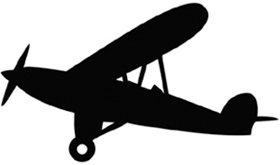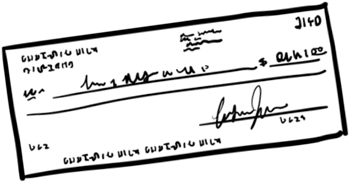Authors: Dan Lewis
Now I Know More (5 page)
On February 6, 1996, Crayola molded its 100 billionth crayon, officially speaking. (It's an estimateâthere's no reason to believe that Crayola kept an accurate count.) To celebrate, the company had a special molder come in to make the historic crayon. Not Emerson Moser, thoughâthat honor went to Fred Rogers, better known from
Mr. Rogers' Neighborhood
.

THE UNLIKELY COLOR OF CAMOUFLAGE
The Supermarine Spitfire was a small aircraft used by the British Royal Air Force in World War II for recon purposes, flying at low altitudes. Typically, Spitfires came with dark colors such as green on top. If an enemy plane were to pass overhead, the green-painted Spitfire would blend in with the terrain below.
But not all of them were green. Some were painted pink.
World War II took place well before the era of spy satellites, drones, and other technological advances that make overhead intel much easier to gather. For the British to know what the Germans were up to, they needed to fly overhead and, literally, take pictures. Many in the Royal Air Force (RAF) were tasked with photo reconnaissance missions, and the Spitfireâa small, one-man fighterâwas one of the few planes able to penetrate (or evade) the Germans' outer defenses. But getting past the perimeter was only the first step toward the ultimate goal. The Spitfire still needed to fly over the targeted areas, take its pictures, and return safely. That required evading detection for much longer, ideally for the entire mission.
The RAF allowed photo recon units to experiment a bit with how to get that part done, especially when it came to painting the planes. Over the course of the war, the Spitfires were outfitted in all sorts of colors. Green made sense when in aerial combat while pink obviously did notâagainst the green backdrop of the ground or ocean below, the Spitfires would be nearly instantly noticed. But when on recon missions, the backdrops were the skies.
So the theory the RAF employed? Paint the planes pink and use the sunsets, sunrises, and most importantly, the clouds as your allies.
As the website
http://io9.com
explained, the cloud layer proved to be excellent cover for these planes. The Spitfires would run their missions at a relatively low altitude, hanging as close to the bottom of the clouds as possible. Enemy planes would have trouble seeing them through or against clouds, as would forces on the ground. The pink planes, which stood out on the ground, were much harder to detect when in the airâwhich is where they were performing their mission.
Very little is known about these planesâthe number painted pink, how frequently they were used, etc. (Given that they were on spy missions, that seems reasonable.) We do know they had a meaningful impact in the outcome of World War II. Many of the photos of pink Spitfires show them decorated with black-and-white stripes on the rear part of the plane. Those stripes were added after D-Day, signifying that the plane was used in support of the successful invasion.
Planes weren't the only things turned “invisible pink” during the war. The Supreme Allied Commander South East Command, Louis Mountbatten, noticed that a ship still in pre-war lavender appeared to vanish against the horizon at dawn and dusk. Believing that this would give the Royal Navy an advantage, Mountbatten ordered that several ships be painted in a dark pink approaching grey, now called Mountbatten Pink. Other naval officers had their ships painted that color, starting a trend. Whether the color provided any actual camouflage value is unknownâit was never tested in any scientific manner.

THE WORLD WAR II BASEBALL GAME WITH TWO LOSERS
Collectively, Baseball Hall of Fame managers Joe McCarthy and Leo Durocher were at the helms of their respective teams for forty-eight seasons, winning well over 4,000 games. Their managerial careers overlapped in the late 1930s and through the 1940s. At times they were cross-town rivalsâfrom 1939 until 1946, McCarthy managed the New York Yankees while Durocher was the skipper for the still-in-Brooklyn Dodgers. Even though there was no interleague play back then, at least twice, the two commanded their teams from the same ballpark. Many baseball fans know about one of them, as McCarthy's Yankees beat Durocher's Dodgers in the 1941 World Series. The other one, though, was a special case. Not only were the Yankees and Dodgers in the same stadium, but they were in the same dugout.
That's because they were both the visiting team. The game was held neither at Yankee Stadium nor at the Dodgers' home turf of Ebbets Field. The teams were at the Polo Grounds, home of the New York Giants. The Giants themselves were there too. They were in the home dugout, and all three teams were playing against each other in one of the strangest games in baseball history.
The date was June 26, 1944. That might seem like a perfectly normal day for a perfectly normal baseball game, but the year changed things. The United States and much of the Western world was caught in the throes of World War II. War is expensive, and just about everyone was doing what they could to support the war effort. New York's sportswriters were no exception. As a scholar writing for the Society for American Baseball Research (SABR) discovered, a group of sportswriters had an idea for a “three-sided” gameâone that's never happened since.
The rules were simple: It was a nine-inning baseball game, but instead of teams alternating their time in the field or at bat, they rotated. In the top of the first, the Dodgers came to bat against the Yankees, and in the bottom of the first, the teams switched sides. Then the Dodgers came back up to the plate for the top of the second. So far, normal. But the team pitching to them now wasn't the Yankees. It was the Giants. The two NL rivals faced off for that inning, and in the third, the Dodgers took a breather in the shared away-team dugout while the Yankees and Giants faced off. This pattern repeated twice over the next six innings.
The Dodgers won the game, with five runs to the Yankees' one and the Giants' zero. But the real winner of this exhibition was the War Bonds effortâthe more than 50,000 people attending the three-way contest purchased an estimated $6.5 million of them during the course of the game.
An unassisted triple play occurs when all three outs in an inning are recorded in one play by the same fielder. It's one of the rarest events in baseball. As of the 2013 Major League Baseball season, there have been only fifteen unassisted triple plays in the league's history. That's rarer than a pitcher throwing a perfect game (twenty-one times since 1900) or a batter slugging four home runs in a game (sixteen times).

WHAT NOT TO DO WITH A CHECK FOR A MILLION DOLLARS
In the baseball world, a team's leadoff hitter has a specific role: get on base and, ultimately, get into a position to score a run. If you ask a baseball fan who is the greatest leadoff hitter of all time, he or she will almost certainly say, “Rickey Henderson.” Henderson, the career leader in both runs scored and stolen bases, was well known for wreaking havoc on pitchers while he was on the base paths.
He also managed to wreak havoc on the Oakland Athletics' finance department.
Henderson made his Major League debut as a member of the A's (as the Athletics have become known) midway through the 1979 season. For the next ten years, he'd play for both the A's and Yankees and was easily the league's biggest base-stealing threatâhe led the league in the category in nine of the ten seasons.
Before the 1990 season, Henderson became a free agent for the first time. While the “Man of Steal” had already earned more than $10 million over his career to that point, Rickey (as he'd refer to himself) was about to get a much larger payday from the A'sâa four-year contract guaranteeing roughly $12 million in salary. Of that $12 million, $1 million was due up front in the form of a signing bonus. The A's paid him by check.
The novelty of a million-dollar check was not lost on Henderson.
After the 1990 season, the A's finance department tried to balance the books, only to find a $1 million overageâthey had too much money in the bank, given what they thought they had paid out. An inquest showed the likely culprit: for some reason, the million-dollar check made out to Henderson had never cleared. The A's called up Rickey and asked if he knew what had happened, and luckily for the finance people, he did.
Henderson never cashed the check. Instead, he had it framed and hung it on one of his walls. The check, as Henderson would later explain, was a constant reminder that he had made itâthat he was a millionaireâand he wanted it to be in a place where he'd see it every day.
The A's asked him to make a copy of the check, frame that copy, and deposit the actual one. Henderson, fortunately, agreed.
There are a lot of really great Henderson stories on the Internet, with varying degrees of truth. For example, despite what some websites say, he never asked a teammate how long it takes to drive to the island nation of the Dominican Republic. But Rickey did once fall asleep on an ice pack, getting frostbite in the processâa malady that made him miss some playing time due to injury.
The term “checkmate” comes from the Persian
shah mat,
which means “the king is helpless.”

HOW A SELF-DESCRIBED POOR PERSON GOT CASH BACK
Gary lives at 15615 North 35th Avenue #114 in Phoenix, Arizona. He is very poor. He probably doesn't mind that we're publishing that information, because he gives it out freely. Or, more accurately, he gives it money-ly, if that's a word. (It's not.) Gary writes his address on dollar bills before he spends them. If you end up with one of them, he asks that you mail it back to him.
And it works.
A CBS affiliate in Gary's area tracked him down (not that it was very difficult) to ask him what's going on here. It turns out that Gary is a sixty-something, legally blind retiree. In 2003, he had to take some unpaid leave from his job due to some health issues. That's when he got the idea of asking people to return his money to him. He used a red pen to get the message across. Each dollar bill that passes through his walletâand he only does this with one- dollar billsâis adorned with a message reading “Please return this bill to me” written at the top, with his address written in the center area around where the word “One” is printed on the bill, and with “I am very poor” at the bottom.

